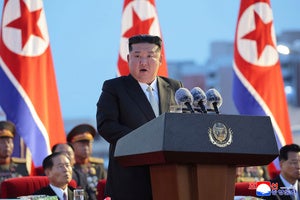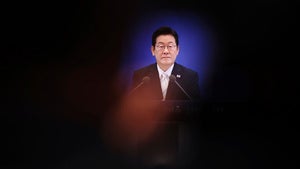The public is open to resuming talks with Pyongyang under certain conditions and sees benefits from trade with Seoul.
The US-South Korea alliance remains one of the most important US alliances in the Indo-Pacific, but it is entering choppy political waters. The first summit between South Korean President Lee Jae-myung and US President Donald Trump was a success on the surface. However, in the weeks that followed, an immigration raid at a Hyundai plant in Georgia led to the arrest and deportation of nearly 400 South Korean nationals, setting off alarms in Seoul. Ongoing negotiations on trade and investment are also creating friction on both sides.
But the Trump administration is not only focused on reorienting relations with allies. President Trump has said he is ready to meet with North Korea’s Kim Jong Un. They met three times in his first presidency, raising speculation that a fourth meeting could take place when Trump travels to South Korea in late October.
The 2025 Chicago Council Survey, fielded July 18-30, finds the American public is open to diplomacy with North Korea, but remains steadfast in its commitment to South Korea. This includes views that trade with South Korea does more to strengthen US national security than weaken it.
Key Findings
- A combined three-quarters (75%) of Americans support US President Donald Trump meeting with North Korean leader Kim Jong Un. This exact percentage shifts slightly depending on the scenario.
- Scenario A: One-third (33%) support a meeting without any preconditions. Forty-five percent say he should meet Kim only if North Korea agrees to first halt missile tests.
- Scenario B: While 38 percent favor a meeting without any preconditions, a further 38 percent support a meeting only if North Korea first agrees to give up its nuclear weapons.
- Just 49 percent of Americans say North Korea’s nuclear program is a critical threat to the United States. This is the first time this has fallen below 50 percent since the question was first asked in 2015.
- Three-quarters of Americans (76%) support focusing on other pressing problems facing the United States besides North Korea.
- Seven in 10 Americans (70%) say trade with South Korea does more to strengthen national security than weaken it.
- Two-thirds (67%) support long-term military bases in South Korea.
Majority Support for Trump-Kim Summit
During his first term, Trump met three times with North Korea’s Kim Jong Un, creating some of the biggest spectacles of his presidency. Taking place in Singapore, Vietnam, and at the demilitarized zone (DMZ) that separates North and South Korea, the meetings produced little in the way of solid results, but did open direct talks between leaders of both countries for the first time. With Trump back in office, speculation has grown on whether he will once again meet Kim. Trump’s bromance with Kim has been well covered, and Kim himself said he had a “good memory” of Trump. The timing of such a meeting is uncertain, but Trump will be traveling to South Korea for APEC meetings at the end of October. A side trip to the DMZ to meet Kim cannot be ruled out.
There is some public support for such a summit. The survey posed two variants on a question about whether Americans thought this would be a good idea. Among half of the survey sample (1,068 respondents), 20 percent say Trump should not meet Kim under any circumstances, and 38 percent favor a meeting without any preconditions. Another 38 percent support such a meeting only if North Korea first agrees to give up its nuclear weapons. That might be a dealbreaker. North Korea recently said it is only open to potential meetings if the United States gives up its calls for denuclearization.
However, the pre-conditions of such a meeting matter when it comes to American public opinion. To test how conditions may change support for a summit, the other half of the sample (1,080 respondents) was asked a question that replaced an agreement to denuclearize with a North Korean pledge to halt missile tests. This would likely be viewed as a softening of the long-standing US demand for denuclearization—although it is unclear how North Korea would respond. In any case, this lower conditional threshold increased support for a summit over the denuclearization pre-condition among the American public overall (45%, +7 percentage points), Republicans (48%, +9 percentage points), Democrats (46%, +5 percentage points), and Independents (43%, +9 percentage points). But that shift came almost exclusively from those that prefer a meeting without preconditions in the denuclearization scenario. The percentage of those that say there should not be a meeting under any circumstances remains virtually unchanged.
Taken together, these findings suggest there is unlikely to be any real discontent from the American public if a meeting with Kim Jong Un materializes in the near future. Not only do Americans generally favor talking to adversaries, but a summit with Kim Jong Un likely ranks very low on a list of priorities and complaints across the bitterly divided US political spectrum. But precedent also likely plays a role, as does eroding perceptions of North Korea’s nuclear program as a critical threat.
Perception of North Korea’s Nuclear Program as Critical Threat Hits New Low
Over the past four years, US-North Korea relations have been relatively dormant. Trump’s flurry of diplomacy with North Korea in his first term was followed by relative inaction under President Joe Biden. Throughout, North Korea has continued to advance both its missile and nuclear programs. However, the American public is now less likely than at any time in the past to say that North Korea’s nuclear program is a critical threat facing the United States. In 2025, just 49 percent say that North Korea’s nuclear program is a critical threat, the first time it has fallen below 50 percent since the Council began asking the question in 2015. This decline may be due in part to ongoing coverage of conflicts in Gaza and Ukraine and deepening US domestic turmoil.
This decline in the perceived threat posed by North Korea’s nuclear program has been bipartisan, with Republicans now at 55 percent, down 10 percentage points from 2021. Democrats (-12 percentage points) and Independents (-8 percentage points) have experienced similar declines in that same time.
The range of policy options in tackling the North Korea challenge are limited. Diplomatic options are constrained due to historical mistrust, wide gulfs in preferred and acceptable diplomatic outcomes, and the very real dangers of military confrontation should tensions escalate.
Perhaps in recognition of these challenges and the lack of progress over the last 30 years, the majority of the American public prefers to deal with North Korea by simply ignoring it. Three-quarters (76%) of Americans favor focusing on “other pressing problems facing the United States besides North Korea” and 71 percent favor isolating and pressuring North Korea with economic sanctions. Forty-four percent support establishing diplomatic relations with North Korea despite their continued development of nuclear weapons. The least favored option—although still substantial—among the American public (32%) is to take military action to force North Korea to give up its nuclear weapons.
These results are notable for their relative consistency across partisanship. However, the most significant gap between Republicans and Democrats comes on willingness to take military action to force North Korea to give up its nuclear weapons. While a minority, 40 percent of Republicans support such military action versus 30 percent of Democrats. This gap is not unusual. In 2021, 51 percent of Republicans favored military action versus 29 percent of Democrats. And in previous versions of this question fielded from 2015 to 2020, Republicans were consistently more likely to favor conducting airstrikes against North Korea’s nuclear production (roughly 20 percentage points more in favor on average) and to favor sending US troops to destroy North Korea’s nuclear facilities (about 11 percentage points more supportive on average).1
Americans Continue to Favor Defending South Korea
Like other countries, South Korea has undertaken a set of contentious trade negotiations with the Trump administration. Trump has long identified South Korea as an unfair trading partner and has made correcting that trade imbalance a center piece of his trade and foreign policies. However, the American public does not see trade with South Korea as a zero-sum game. Instead, Americans see a close connection between trade and security, with 70 percent saying trade with South Korea does more to strengthen US national security than it does to weaken US national security (24%).
This tie between trade and security helps to inform the consistent support of the American public for long-term US military bases in South Korea. In 2025, 67 percent of Americans say the United States should have long-term military bases in South Korea. While that support has fluctuated since the Council began asking the question in 2022, it has never fallen below 60 percent overall, as recorded in 2010 and 2012. Importantly, this support remains bipartisan, with Republicans typically more strongly supporting the US military presence in South Korea.
Beyond support for maintaining long-term military bases in South Korea—which could have several important factors—the most immediate potential use of those bases is likely seen as defending South Korea. In that scenario, a majority of Americans (52%) support using US troops to defend South Korea if North Korea invaded. This has been the case since 2017, when 62 percent said the same, indicating an increase from the first years of Council polling on this hypothetical scenario. In the years from 1990 to 2015, only a minority of Americans overall supported defending South Korea in the case of a North Korean invasion.
The drivers of this shift in American public opinion are unclear, but it seems to have taken place across the political spectrum. While Republicans have typically been more likely to favor defending South Korea, they were not overwhelmingly so. From 1990 to 2015, Republicans ranged from a low of 33 percent in 1998 to a high of 55 percent in 2006. In that same time period, Democrats ranged from 28 percent in 1998 to 50 percent in 2015. And Independents hit a low of 33 percent in 1998 to a high of 46 percent in 2014. From 2017, however, there is a notable shift among all partisans in favor of defending South Korea, although those attitudes have begun to slip toward previous norms from 2023.
There does not appear to be a single reason that explains this shift from 2015 to 2017, nor why it has proven to be so lasting. North Korea’s 2016 and 2017 nuclear tests, its ongoing missile tests, the rise of South Korea’s cultural power, and resonant events such as the death of American tourist Otto Warmbier likely all contributed to the shift and its durability.
Conclusion
The American public remains highly supportive of the relationship with South Korea and is prepared to back some form of diplomacy with North Korea. But how these relationships develop in the next three years will depend on the direction of the Trump administration. Should it pursue diplomacy with North Korea, it will have an eager partner in South Korea’s Lee Jae Myung. But should it continue to target South Korea with demands of cash investment, and then co-mingle those demands with implicit threats that target the US security guarantee, it could reawaken a long-dormant anti-Americanism among the South Korea public and push Seoul to consider new ways to take its security into its own hands.
Appendix Table 1
Below is a list of possible threats to the vital interests of the United States in the next 10 years. For each one, please select whether you see this as a critical threat, an important but not critical threat, or not an important threat at all.
| Overall | Republican | Democrat | Independent | R-D Gap | |
|---|---|---|---|---|---|
| 2015 | 55 | 58 | 53 | 56 | 5 |
| 2016 | 60 | 63 | 64 | 52 | -1 |
| 2017 | 75 | 80 | 76 | 70 | 4 |
| 2018 | 59 | 61 | 62 | 53 | -1 |
| 2019 | 61 | 67 | 62 | 55 | 5 |
| January 2020 | 52 | 57 | 58 | 41 | -1 |
| 2020 | 51 | 53 | 54 | 47 | -1 |
| March 2021 | 59 | 65 | 61 | 53 | 4 |
| 2022 | 52 | 57 | 55 | 45 | 2 |
| 2023 | 52 | 57 | 53 | 48 | 4 |
| 2024 | 52 | 59 | 53 | 45 | 6 |
| 2025 | 49 | 55 | 49 | 45 | 6 |
Appendix Table 2
There has been some discussion about the circumstances that might justify using US troops in other parts of the world. Please give your opinion about some situations. Would you favor or oppose the use of US troops:
| Overall | Republican | Democrat | Independent | R-D Gap | |
|---|---|---|---|---|---|
| 1990 | 44 | 53 | 40 | 43 | 13 |
| 1994 | 39 | N/A | N/A | N/A | N/A |
| 1998 | 30 | 33 | 28 | 33 | 5 |
| 2002 | 36 | 50 | 31 | 37 | 19 |
| 2004 | 43 | 49 | 43 | 39 | 6 |
| 2006 | 45 | 55 | 42 | 41 | 13 |
| 2008 | 41 | 51 | 32 | 45 | 19 |
| 2010 | 40 | 47 | 38 | 36 | 9 |
| 2012 | 41 | 51 | 40 | 36 | 11 |
| 2014 | 47 | 53 | 44 | 46 | 9 |
| 2015 | 47 | 53 | 50 | 42 | 3 |
| 2017 | 62 | 70 | 59 | 61 | 11 |
| 2018 | 64 | 70 | 63 | 61 | 7 |
| 2019 | 58 | 63 | 57 | 56 | 6 |
| 2020 | 58 | 57 | 58 | 58 | -1 |
| March 2021 | 53 | 57 | 51 | 53 | 6 |
| 2021 | 63 | 68 | 61 | 62 | 7 |
| 2022 | 55 | 54 | 58 | 53 | -4 |
| 2023 | 50 | 46 | 57 | 48 | -11 |
| 2024 | 51 | 52 | 54 | 49 | -2 |
| 2025 | 52 | 58 | 50 | 50 | 8 |
Appendix Table 3
Do you think the United States should or should not have long-term military bases in the following places?
| Overall | Republican | Democrat | Independent | R-D Gap | |
|---|---|---|---|---|---|
| 2002 | 67 | 74 | 66 | 64 | 8 |
| 2004 | 62 | 71 | 62 | 56 | 9 |
| 2006 | 62 | 73 | 57 | 61 | 16 |
| 2008 | 63 | 72 | 59 | 59 | 13 |
| 2010 | 60 | 68 | 58 | 58 | 10 |
| 2012 | 60 | 68 | 57 | 58 | 11 |
| 2014 | 64 | 70 | 61 | 64 | 9 |
| 2016 | 70 | 76 | 70 | 64 | 6 |
| 2018 | 74 | 79 | 73 | 71 | 6 |
| January 2020 | 69 | 80 | 65 | 65 | 15 |
| March 2021 | 66 | 70 | 65 | 65 | 5 |
| 2022 | 72 | 77 | 72 | 69 | 5 |
| 2023 | 64 | 63 | 66 | 62 | -3 |
| 2024 | 63 | 67 | 61 | 63 | 6 |
| 2025 | 67 | 74 | 65 | 65 | 9 |
Appendix Table 4
Does trade between the US and the following countries do more to strengthen US national security or weaken US national security?
| Overall | Republican | Democrat | Independent | R-D Gap | |
|---|---|---|---|---|---|
| 2025 | 70 | 63 | 76 | 71 | -13 |
| Overall | Republican | Democrat | Independent | R-D Gap | |
|---|---|---|---|---|---|
| 2025 | 24 | 31 | 20 | 23 | 11 |
Appendix Table 5
Please tell me whether you would support or oppose each of the following kinds of US actions in its relations with North Korea:
| Overall | Republican | Democrat | Independent | R-D Gap | |
|---|---|---|---|---|---|
| 2021 | 44 | 38 | 43 | 50 | -5 |
| 2022 | 46 | 44 | 46 | 47 | -2 |
| 2025 | 44 | 47 | 42 | 44 | 5 |
| Overall | Republican | Democrat | Independent | R-D Gap | |
|---|---|---|---|---|---|
| 2021 | 70 | 77 | 65 | 70 | 12 |
| 2022 | 75 | 79 | 77 | 71 | 2 |
| 2023 | 75 | 79 | 75 | 74 | 4 |
| 2025 | 71 | 78 | 69 | 68 | 9 |
| Overall | Republican | Democrat | Independent | R-D Gap | |
|---|---|---|---|---|---|
| 2021 | 35 | 51 | 29 | 30 | 22 |
| 2022 | 31 | 35 | 29 | 29 | 6 |
| 2023 | 28 | 29 | 29 | 28 | 0 |
| Aug. 2024 | 24 | 32 | 18 | 23 | 14 |
| 2025 | 32 | 40 | 30 | 28 | 10 |
| Overall | Republican | Democrat | Independent | R-D Gap | |
|---|---|---|---|---|---|
| 2022 | 77 | 77 | 78 | 78 | -1 |
| 2023 | 79 | 80 | 81 | 79 | -1 |
| 2025 | 76 | 80 | 74 | 75 | 6 |
Appendix Table 6
Under what conditions should Donald Trump meet with North Korea’s Kim Jong Un? (Nuclear Weapons) *In 2022, the question referred to former US President Joe Biden*
| Overall | Republican | Democrat | Independent | R-D Gap | |
|---|---|---|---|---|---|
| 2022 | 26 | 37 | 21 | 23 | 16 |
| 2025 | 20 | 7 | 29 | 22 | -22 |
| Overall | Republican | Democrat | Independent | R-D Gap | |
|---|---|---|---|---|---|
| 2022 | 37 | 32 | 40 | 39 | -8 |
| 2025 | 38 | 39 | 41 | 34 | -2 |
| Overall | Republican | Democrat | Independent | R-D Gap | |
|---|---|---|---|---|---|
| 2022 | 32 | 29 | 35 | 33 | -6 |
| 2025 | 38 | 49 | 27 | 40 | 22 |
Appendix Table 7
Under what conditions should Donald Trump meet with North Korea’s Kim Jong Un? (Missile Tests) *In 2022, the question referred to former US President Joe Biden*
| Overall | Republican | Democrat | Independent | R-D Gap | |
|---|---|---|---|---|---|
| 2022 | 30 | 39 | 24 | 28 | 15 |
| 2025 | 19 | 9 | 26 | 19 | -17 |
| Overall | Republican | Democrat | Independent | R-D Gap | |
|---|---|---|---|---|---|
| 2022 | 46 | 39 | 56 | 42 | -17 |
| 2025 | 45 | 48 | 46 | 43 | 2 |
| Overall | Republican | Democrat | Independent | R-D Gap | |
|---|---|---|---|---|---|
| 2022 | 22 | 20 | 19 | 28 | 1 |
| 2025 | 33 | 41 | 25 | 34 | 16 |
This analysis is primarily based on data from the 2025 Chicago Council Survey of the American public on foreign policy, a project of the Lester Crown Center on US Foreign Policy.
The 2025 Chicago Council Survey was conducted July 18-30, 2025, by Ipsos using its large-scale nationwide online research panel (KnowledgePanel) in English and Spanish among a weighted national sample of 2,148 adults 18 or older living in all 50 US states and the District of Columbia. The margin of sampling error for the full sample is ±2.2 percentage points, including a design effect of 1.07.
Partisan identification is based on how respondents answered a standard partisan self-identification question: “Generally speaking, do you think of yourself as a Republican, a Democrat, an Independent, or what?”
The 2025 Chicago Council Survey is made possible by the generous support of the Crown family and the Korea Foundation.
Additional results reported from August 2025 are from a Chicago Council on Global Affairs-Ipsos survey conducted August 22-24, 2025 by Ipsos using its large-scale, nationwide, online research panel (KnowledgePanel) among a weighted national sample of 1,021 adults 18 or older living in all 50 US states and the District of Columbia. The margin of sampling error for the full sample is ±3.1 percentage points including a design effect of 1.05.
The data for the total sample were weighted to adjust for gender by age, race/ethnicity, education, Census region, metropolitan status, and household income using demographic benchmarks from the 2024 March Supplement of the Current Population Survey (CPS). The specific categories used were:
- Gender (Male, Female) by Age (18–29, 30–44, 45-59 and 60+)
- Race/Hispanic Ethnicity (White Non-Hispanic, Black Non-Hispanic, Other, Non-Hispanic, Hispanic, 2+ Races, Non-Hispanic)
- Education (Less than High School, High School, Some College, Bachelor or higher)
- Census Region (Northeast, Midwest, South, West)
- Metropolitan status (Metro, non-Metro)
- Household Income (Under $25,000, $25,000-$49,999, $50,000-$74,999, $75,000-$99,999, $100,000-$149,999, $150,000+)
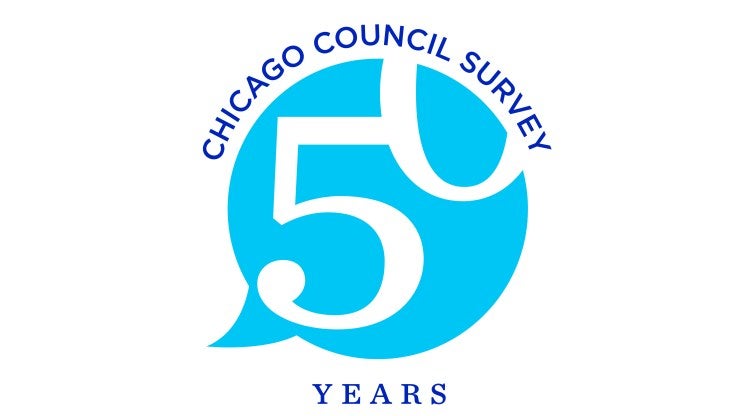


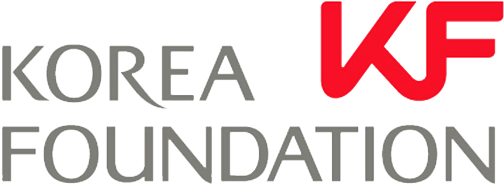
Related Content
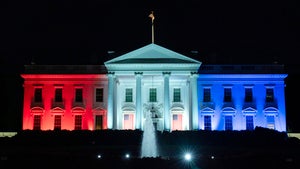 US Foreign Policy
US Foreign Policy
Results and analysis of the Council's annual survey of American views on foreign policy.
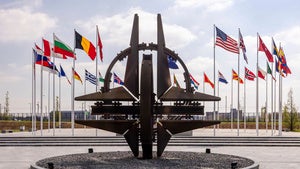 US Foreign Policy
US Foreign Policy
Solid majorities of Democrats and Independents think the United States should consult with allies before making major foreign policy decisions, but only four in 10 Republicans agree.
